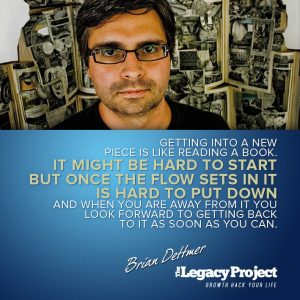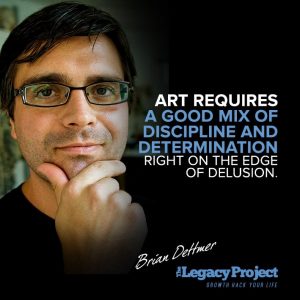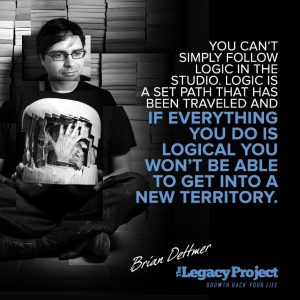Brian Dettmer is a New York-based artist known for his detailed and innovative sculptures with books and other forms of antiquated media. Dettmer’s work has been exhibited internationally in numerous solo and group exhibitions at galleries, museums and art centers.
 My Definition Of Success | When I was in college my idea of success was making a living off of my work and having some recognition for what I do, what people sometimes refer to as “making it”. I was able to quit my day job about 10 years ago. I had in Chicago a few years ago I ran into an old friend and she proclaimed, “You made it”. I said, “of course I did, this is my show”, confused as if there was some speculation that I wouldn’t be able to attend. She said, “No, You Made It!” proclaiming it that I had achieved success. I thought for a second about how I used to perceive success and realized I guess I had “made it”, but it wasn’t the way I thought it would be years earlier. I did make it but I am still making it every day and need to continue to make it. It has never felt like I reached the top of a mountain. It is more of a long journey and when you reach one peak you then see another higher ridge off in the distance. You can take breaks, but you can never really stop and proclaim that you have made it. Now I think of success as the recognition that I carved a new trail to get to my goal rather than having arrived at a specific peak.
My Definition Of Success | When I was in college my idea of success was making a living off of my work and having some recognition for what I do, what people sometimes refer to as “making it”. I was able to quit my day job about 10 years ago. I had in Chicago a few years ago I ran into an old friend and she proclaimed, “You made it”. I said, “of course I did, this is my show”, confused as if there was some speculation that I wouldn’t be able to attend. She said, “No, You Made It!” proclaiming it that I had achieved success. I thought for a second about how I used to perceive success and realized I guess I had “made it”, but it wasn’t the way I thought it would be years earlier. I did make it but I am still making it every day and need to continue to make it. It has never felt like I reached the top of a mountain. It is more of a long journey and when you reach one peak you then see another higher ridge off in the distance. You can take breaks, but you can never really stop and proclaim that you have made it. Now I think of success as the recognition that I carved a new trail to get to my goal rather than having arrived at a specific peak.
I Am Driven By | Part of what drives me is this journey or destination that may be unreachable because the same metaphor applies in the studio with my work as it does outside of the studio with my career. Every time I reach a certain point with my artwork it opens my eyes into a new direction. This is what makes the work interesting. As an artist, if you want to make detailed and interesting things that will have an impact on people and sustain time, you need to enjoy being in the studio more than anything else. To me, it is a necessity. It is where I have the most control and also the most space for experimentation and flexibility. It is a slow meditation, a series of discoveries that lead to reward. Getting into a new piece is like reading a book. It might be hard to start but once the flow sets in it is hard to put down and when you are away from it you look forward to getting back to it as soon as you can.
The Difference Between Good And Great | I think it is this determination or drive. As an artist, you need the desire and the discipline to be in the studio every day. You have to want it. You have to love it. You almost have to need it because it isn’t as easy or glamorous as many young artists imagine it might be. You can never merely see time as money in the studio. If you do, you might be closing the path to your next great idea. I can spend hours or even days working on something that feels like it is going nowhere but then, months later it creates a spark that leads into a new and exciting direction.
A Key Talent | As an artist, I think two important and practical things (outside of the actual artwork) are to learn how to photograph your own work and how to write and talk about your ideas. Only a fraction of my audience will actually see my sculptures in person (compared to images online and in books), so it is essential that I get good images. Learning to do this yourself will save you money but more importantly, time. It also gives you total control over how you represent your work. So, step by step- Buy a nice SLR camera with great resolution because it is important to have high-quality images, get 2-3 professional lights and use 500 watt tungsten bulbs and teach yourself how to use Photoshop and how to create the most effective and clear representations of your work. As far as writing goes, you need to learn how to put your ideas into words, which is often very difficult with visual art. It’s important to use the right language to describe your ideas and your work clearly, not to try to impress people with large words and confusing art-speak. You want to communicate your ideas but also keep them open enough for others to interpret in their own way. The next thing I think that is critical to success is to share your images and ideas with as many people as possible. It is important to get it out there as much as possible in the beginning of your career.
 The Characteristics Of Success | I think art requires a good mix of discipline and determination right on the edge of delusion. You have to head in new directions, often against all logic, because you might be going towards interesting or groundbreaking territory. But you also need to be able to stay distant enough to be able to drop it if you are headed towards a dead end. This is certainly true with art and science and probably in business as well.
The Characteristics Of Success | I think art requires a good mix of discipline and determination right on the edge of delusion. You have to head in new directions, often against all logic, because you might be going towards interesting or groundbreaking territory. But you also need to be able to stay distant enough to be able to drop it if you are headed towards a dead end. This is certainly true with art and science and probably in business as well.
Principles I Live By | I work with existing books so I am aware that my work derives from the images and ideas of others. In a way, you can say that I am stealing and even Picasso said (although the source has been debated) that a great artist needs to know how to steal. Because my work questions the idea of an authority and works with pre-existing media, transparency and honesty are very important to me. I never want to take credit for the work of others, only for the way I interpret and remix it. I am trying to illustrate how this happens in the digital world every day and how appropriation can be a slippery slope. It is very important for me to be honest about my sources and to illustrate the complexity and conflicts that arise as our media loses form and original sources become lost.
How I Use My Mind | The most interesting art is work that allows people to see something in a new way. You can’t simply follow logic in the studio. Logic is a set path that has been traveled and if everything you do is logical you won’t be able to get into a new territory. This can often look like insanity from the outside world, and sometimes it is; but the most important thing about being an artist is to let yourself go in those directions to find new ways to think and new ways to make others see. You need to think about your subject in as many directions as possible and try to make new connections. Most importantly, you need to be able to let yourself fail. I suppose this is true in any field, but the great thing about art is that success in a work isn’t always measured in a financial way. The most important thing is how it pushes the history further and how it can make people see something in a new way.
Lessons I Have Learnt | In the art world, the big cliché or major complaint you hear from younger artists is that it is all about who you know. This is true in any field to a degree but I think this sentiment is backwards for the most part. It is more about who knows you, or more importantly, who knows your work. So, I always tell students when I lecture that you need to get your work out there as much as possible. Most success and recognition works from the bottom up in the digital age so you need to plant as many seeds as possible. The more you get it out there, the more likely it is that opportunities will come to you.
Resources I Use To Stay Inspired | I love this question because as an artist people are always just asking me what other artists I am influenced by. Most of my influences come from outside of the visual art world, or somewhere in the space between disciplines. I read a lot of media theory and philosophy. I am inspired by current events and cultural shifts and I think about how they relate to the situation the physical book and our information ecology is in today. I listen to a lot of music and think about time structure and narrative, alternatives and variations on a single theme. Architecture also has a large influence on me. I think about the relationship between form and function and how concepts and aesthetics can communicate unconsciously and guide an idea, direction or emotion. To be more specific and name drop a few- Jorge Luis Borges, Freidrich Kittler, Italo Calvino, Vilem Flusser, Rem Koolhaus, DJ Spooky and Werner Herzog are all inspirations that have informed and mirrored the way I see the world.
 The Best Advice I’ve Received | I mentioned it earlier and it sounds simple, but it has stuck with me. While in college, a painter named Hollis Sigler, told us that you need to be in the studio every day. Even it is just for an hour or so, get in the studio to keep it close, otherwise it might float away. This is paraphrased of course, but I have held this idea with me. It has helped and proven to be true. If I am out of the studio for a week due to travel, it can take a half a week to fully get back into my work. You need to keep it close and be in the studio everyday to keep it from drifting away.
The Best Advice I’ve Received | I mentioned it earlier and it sounds simple, but it has stuck with me. While in college, a painter named Hollis Sigler, told us that you need to be in the studio every day. Even it is just for an hour or so, get in the studio to keep it close, otherwise it might float away. This is paraphrased of course, but I have held this idea with me. It has helped and proven to be true. If I am out of the studio for a week due to travel, it can take a half a week to fully get back into my work. You need to keep it close and be in the studio everyday to keep it from drifting away.
I Am Inspired By | I’ll contradict my earlier statement and confess that I am influenced by the way some artists have lived, how they think, and the work that they do. Duchamp and Rauschenberg would be my two main historical role models. Joseph Beuys and Ray Johnson as well, for the way they lived their art. Tom Phillips and Mimmo Rotella have had strong parallels to my work. A few of my contemporary inspirations in life and art would be- Tony Fitzpatrick, Buzz Spector, Kenneth Goldsmith, Vik Muniz, Tom Friedman (the artist/sculptor, not the writer…maybe the writer a little bit), and Tim Hawkinson, to name a few. I don’t think I am directly inspired by their work as much as I am by the way they think and the way they have each pushed their art in a new direction that I can relate to.
*Photo by Ilia Varcev



